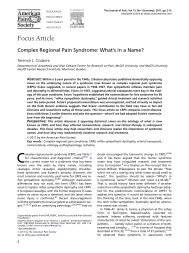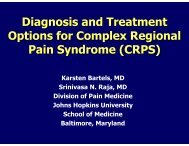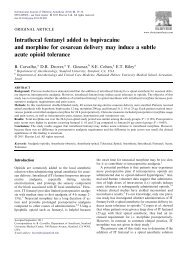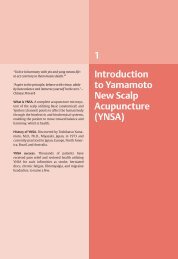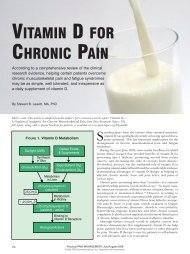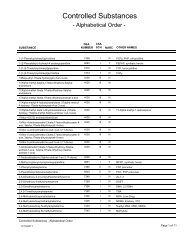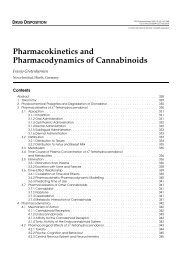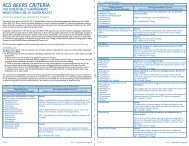GLIA: A NOVEL DRUG DISCOVERY TARGET FOR CLINICAL PAIN
GLIA: A NOVEL DRUG DISCOVERY TARGET FOR CLINICAL PAIN
GLIA: A NOVEL DRUG DISCOVERY TARGET FOR CLINICAL PAIN
Create successful ePaper yourself
Turn your PDF publications into a flip-book with our unique Google optimized e-Paper software.
REVIEWS35. Harrison, J. K. et al. Role for neuronally derived fractalkinein mediating interactions between neurons andCX3CR1-expressing microglia. Proc. Natl Acad. Sci. USA95, 10896–10901 (1998).36. Watkins, L. R., Milligan, E. D. & Maier, S. F. in Advances inPain Research and Therapy (eds Dostrovsky, J. O., Carr, D. B.& Koltzenberg, M.) 369–385 (IASP, Seattle, 2003).37. Verge, G. et al. Mapping fractalkine and its receptor(CX3CR1) in a rat model of sciatic inflammatory neuropathy(SIN). Proc. Soc. Neurosci. 28, 455.3 (2002).38. Chapman, G. A. et al. Fractalkine cleavage from neuronalmembranes represents an acute event in the inflammatoryresponse to excitotoxic brain damage. J. Neurosci. 20,RC87 (1–5) (2000).39. Dinarello, C. A. in Cytokines and Pain (eds Watkins, L. R. &Maier, S. F.) 1–19 (Birkhauser, Basel, 1999).An excellent review of pro-inflammatory cytokinemolecular biology and cellular signalling, with a focuson their role in pain facilitation.40. Maier, S. F. & Watkins, L. R. Cytokines for psychologists:implications of bi-directional immune-to-braincommunication for understanding behavior, mood, andcognition. Psychol. Rev. 105, 83-107 (1998).This review article examines the role ofpro-inflammatory cytokines in a wide array ofperipheral, brain and spinal cord processes.It is aimed at non-specialists to introduce themto this research area41. DeLeo, J. A., Colburn, R. W., Nochols, M. & Malhotra, A.Interleukin-6-mediated hyperalgesia/allodynia and increasedspinal IL-6 expression in a rat mononeuropathy model.J. Interferon Cytokine Res. 16, 695–700 (1996).42. Falchi, M., Ferrara, G., Gharib, C. & Dib, B. Hyperalgesiceffect of intrathecally administered interleukin-1 in rats.Drugs Exp. Clin. Res. 27, 97–101 (2001).43. Reeve, A. J., Patel, S., Fox, A., Walker, K. & Urban, L.Intrathecally administered endotoxin or cytokines produceallodynia, hyperalgesia and changes in spinal cord neuronalresponses to nociceptive stimuli in the rat. Eur. J. Pain 4,247–257 (2000).44. Tadano, T. et al. Induction of nociceptive responses byintrathecal injection of interleukin-1 in mice. Life Sci. 65,255–261 (1999).45. Oka, T. & Hori, T. in Cytokines and Pain (eds Watkins, L. R.& Maier, S. F.) 183–204 (Birkhauser, Basel, 1999).46. Sweitzer, S. M., Martin, D. & DeLeo, J. A. Intrathecalinterleukin-1 receptor antagonist in combination with solubletumor necrosis factor receptor exhibits an anti-allodynicaction in a rat model of neuropathic pain. Neurosci. 103,529–539 (2001).47. Clark, A. R., Dean, J. L. E. & Saklatvala, J. Posttranscriptionalregulation of gene expression by mitogenactivatedprotein kinase p38. FEBS Lett. 546, 37–44(2003).48. Svensson, C. I. et al. Activation of p38 MAP kinase in spinalmicroglia is a critical link in inflammation induced spinal painprocessing. J. Neurochem. (in the press).49. Svensson, C. I., Hua, X. Y., Protter, A. A., Powell, H. C. &Yaksh, T. L. Spinal p38 MAP kinase is necessary for NMDAinduced spinal PGE 2release and thermal hyperalgesia.Neuroreport 14, 1153–1157 (2003).50. Schafers, M., Svensson, C. I., Sommer, C. & Sorkin, L. S.Tumor necrosis factor induces mechanical allodynia afterspinal nerve ligation by activation of p38 MAPK in primarysensory neurons. J. Neurosci. 23, 2517–2521 (2003).51. Jones, T. L. et al. Involvement of p38α MAPK incapsaicin-induced hyperalgesia. Proc. Soc. Neurosci.28, 56.5 (2002).52. Milligan, E. D. et al. Systemic administration of CNI-1493, ap38 MAP kinase inhibitor, blocks HIV-1 gp120-inducedenhanced pain states in rats. J. Pain 2, 326–333 (2001).53. Sweitzer, S. M., Schubert, P. & DeLeo, J. A. Propentofylline,a glial modulating agent, exhibits antiallodynic properties in arat model of neuropathic pain. J. Pharmacol. Exp. Ther. 297,1210–1217 (2001).54. Winkelstein, B. A., Rutkowski, M. D., Sweitzer, S. M.,Pahl, J. L. & DeLeo, J. A. Nerve injury proximal or distal tothe DRG induces similar spinal glial activation and selectivecytokine expression but differential behavioral responses topharmacologic treatment. J. Comp. Neurol. 2, 127–139(2001).55. Hashizume, H., Rutkowski, M. D., Weinstein, J. N. &DeLeo, J. A. Central administration of methotrexate reducesmechanical allodynia in an animal model ofradiculopathy/sciatica. Pain 87, 159–169 (2000).56. Sommer, C., Marziniak, M. & Myers, R. R. The effect ofthalidomide treatment on vascular pathology andhyperalgesia caused by chronic constriction injury of ratnerve. Pain 74, 83–91 (1998).57. George, A., Marziniak, M., Schafers, M., Toyka, K. V. &Sommer, C. Thalidomide treatment in chronic constrictiveneuropathy decreases endoneurial tumor necrosis factor-α,increases interleukin-10 and has long-term effects on spinalcord dorsal horn met-enkephalin. Pain 88, 267–275 (2000).58. Eriksson, T., Bjorkman, S. & Hoglund, P. Clinicalpharmacology of thalidomide. Eur. J. Clin. Pharmacol. 5,365–376 (2001).59. Clemmensen, O. J., Olsen, P. Z. & Andersen, K. E.Thalidomide neurotoxicity. Arch. Dermatol. 120, 338–341(1984).60. Strle, K. et al. Interleukin-10 in the brain. Crit. Rev. Immunol.21, 427–449 (2001).61. Moore, K. W., deWaal Malefyt, R., Coffman, R. L. &O’Garra, A. Interleukin-10 and the interleukin-10 receptor.Annu. Rev. Immunol. 19, 683–765 (2001).62. Ledeboer, A. et al. Regional and temporal expressionpatterns of interleukin-10, interleukin-10 receptor andadhesion molecules in the rat spinal cord during chronicrelapsing EAE. J. Neuroimmunol. 136, 94–103 (2003).63. Yu, C.-G., Fairbanks, C. A., Wilcox, G. L. & Yezierski, R. P.Effects of agmatine, interleukin-10 and cyclosporin onspontaneous pain behavior following excitotoxic spinal cordinjury in rats. J. Pain (in the press).64. Laughlin, T. M., Bethea, J. R., Yezierski, R. P. & Wilcox, G. L.Cytokine involvement in dynorphin-induced allodynia. Pain84, 159–167 (2000).65. Plunkett, J. A., Yu, C.-G., Easton, J. M., Bethea, J. R. &Yezierski, R. P. Effects of interelukin-10 (IL-10) on painbehavior and gene expression following excitotoxic spinalcord injury in the rat. Exper. Neurol. 168, 144–154 (2001).66. Hornfeldt, C. S. & Larson, A. A. Seizures induced byfluoroacetic acid and fluorocitric acid may involve chelationof divalent cations in the spinal cord. Eur. J. Pharmacol. 179,307–313 (1990).67. Yrjanheikki, J., Keinanen, R., Pellikka, M., Hokfelt, T. &Korstinaho, J. Tetracyclines inhibit microglial activation andare neuroprotective in global brain ischemia. Neurobiology95, 15769–15774 (1998).68. Lin, S. et al. Minocycline blocks nitric oxide-inducedneurotoxicity by inhibition of p38 MAP kinase in rat cerebellargranule neurons. Neurosci. Lett. 315, 61–64 (2001).69. Kary, S. & Burmester, G. R. Anakinra: the first interleukin-1inhibitor in the treatment of rheumatoid arthritis. Int. J. Clin.Pract. 57 (2003).70. Calabrese, L. H. Molecular differences in anticytokinetherapies. Clin. Exp. Rheumatol. 21, 241–248 (2003).71. Mielke, R. et al. Propentofylline in the treatment of vasculardementia and Alzheimer-type dementia: overview of phase Iand phase II clinical trials. Alzheimer Dis. Assoc. Disord. 12,S29–35 (1998).72. Rother, M. et al. Propentofylline in the treatment ofAlzheimer’s disease and vascular dementia: a review ofphase III trials. Dement. Geriatr. Cogn. Disord. 9, 36–43(1998).73. Plaschke, K. et al. Neuromodulatory effect ofpropentofylline on rat brain under acute and long-termhypoperfusion. Br. J. Pharmacol. 133, 107–116 (2001).74. Wu, Y. P., McRae, A., Rudolphi, K. & Ling, E. A.Propentofylline attenuates microglial reaction in the rat spinalcord induced by middle cerebral artery occlusion. Neurosci.Lett. 260, 17–20 (1999).75. Numagami, Y., Marro, P. J., Mishra, O. P. & Delivoria-Papadopoulos, M. Effect of propentofylline on free radicalgeneration during cerebral hypoxia in the newborn piglet.Neuroscience 84, 1127–1133 (1998).76. Schubert, P. et al. Cascading glia reactions: a commonpathomechanism and its differentiated control by cyclicnucleotide signaling. Ann. NY Acad. Sci. 903, 24–33(2000).77. Schubert, P., Ogata, T., Marchini, C., Ferroni, S. &Rudolphi, K. Protective mechanisms of adenosine inneurons and glial cells. Ann. NY Acad. Sci. 825, 1–10 (1997).78. Sawynok, J. & Liu, X. J. Adenosine in the spinal cord andperiphery: release and regulation of pain. Prog. Neurobiol.69, 313–340 (2003).79. Si, Q., Nakamura, Y., Ogata, T., Kataoka, K. & Schubert, P.Differential regulation of microglial activation by propentofyllinevia cAMP signaling. Brain Res. 812, 97–104 (1998).80. Matthews, S. J. & McCoy, C. Thalidomide: a review ofapproved and investigational uses. Clin. Ther. 25, 342–395(2003).81. Mujagic, H., Chabner, B. A. & Mujagic, Z. Mechanisms ofaction and potential therapeutic uses of thalidomide. Croat.Med. J. 43, 274–285 (2002).82. Majumdar, S., Lamothe, B. & Aggarwal, B. B. Thalidomidesuppresses NF-κB activation induced by TNF and H 2O 2,but not that activated by ceramide, lipopolysaccharides, orphorbol ester. J. Immunol. 168, 2644–2651 (2002).83. Gallily, R., Kipper-Galperin, M. & Brenner, T. Mycoplasmafermentans-induced inflammatory response of astrocytes:selective modulation by aminoguanidine, thalidomide,pentoxifylline and IL-10. Inflammation 23, 495–505 (1999).84. Peterson, P. K. et al. Thalidomide inhibits tumor necrosisfactor-α production by lipopolysaccharide- andlipoarabinomannan-stimulated human microglial cells.J. Infect. Dis. 172, 1137–1140 (1995).85. Moreira, A. L. et al. Thalidomide exerts its inhibitory actionon tumor necrosis factor-α by enhancing mRNAdegradation. J. Exp. Med. 177, 1675–1680 (1993).86. Corral, L. G. et al. Differential cytokine modulation and T cellactivation by two distinct classes of thalidomide analoguesthat are potent inhibitors of TNF-α. J. Immunol. 163,380–386 (1999).87. Li, J., Luo, S., Hong, W., Zhou, Z. & Zou, W. Influence ofthalidomide on interleukin-6 and its transmission in multiplemyeloma patients. Zhonghua Zhong Liu Za Zhi 24,254–256 (2002).88. Bauditz, J., Wedel, S. & Lochs, H. Thalidomide reducestumour necrosis factor-α and interleukin-12 production inpatients with chronic active Crohn’s disease. Gut 50,196–200 (2002).89. Jin, S. H., Kim, T. I., Han, D. S., Shin, S. K. & Kim, W. H.Thalidomide suppresses the interleukin 1β-induced NF-κBsignaling pathway in colon cancer cells. Ann. NY Acad. Sci.973, 414–418 (2002).90. Thiele, A. et al. Cytokine modulation and suppression of liverinjury by a novel analogue of thalidomide. Eur. J. Pharmacol.453, 325–334 (2002).91. Rajkumar, S. V., Fonseca, R. & Witzig, T. E. Completeresolution of reflex sympathetic dystrophy with thalidomidetreatment. Arch. Intern. Med. 161, 2502–2503 (2001).92. Prager, J., Fleischman, J. & Lingua, G. Open label clinicalexperience of thalidomide in the treatment of complexregional pain syndrome Type 1. J. Pain 4, S68 (2003).93. Sanders, S. & Harisdangkul, V. Leflunomide for thetreatment of rheumatoid arthritis and autoimmunity.Am. J. Med. Sci. 323, 190–193 (2002).94. Furst, D. E. Innovative treatment approaches for rheumatoidarthritis. Cyclosporin, leflunomide and nitrogen mustard.Baillieres Clin. Rheumatol. 9, 711–729 (1995).95. Kraan, M. C. et al. Modulation of inflammation andmetalloproteinase expression in synovial tissue byleflunomide and methotrexate in patients with activerheumatoid arthritis. Findings in a prospective,randomized, double-blind, parallel-design clinical trial inthirty-nine patients at two centers. Arthritis Rheum. 43,1820–1830 (2000).96. Elkayam, O. et al. Active leflunomide metabolite inhibitsinterleukin-1β, tumour necrosis factor-α, nitric oxide, andmetalloproteinase-3 production in activated humansynovial tissue cultures. Ann. Rheum. Dis. 62, 440–443(2003).97. Cutolo, M. et al. Anti-inflammatory effects of leflunomide oncultured synovial macrophages from patients withrheumatoid arthritis. Ann. Rheum. Dis. 62, 297–302 (2003).98. Manna, S. K., Mukhopadhyay, A. & Aggarwal, B. B.Leflunomide suppresses TNF-induced cellular responses:effects on NF-κB, activator protein-1, c-Jun N-terminalprotein kinase, and apoptosis. J. Immunol. 165, 5962–5969(2000).99. Fox, R. I. et al. Mechanism of action for leflunomide inrheumatoid arthritis. Clin. Immunol. 93, 198–208 (1999).100. Herrmann, M. L., Schleyerbach, R. & Kirschbaum, B. J.Leflunomide: an immunomodulatory drug for the treatmentof rheumatoid arthritis and other autoimmune diseases.Immunopharmacology 47, 273–289 (2000).101. Miljkovic, D. et al. Leflunomide inhibits activation of induciblenitric oxide synthase in rat astrocytes. Brain Res. 889,331–338 (2001).102. Bao, L. et al. Adjuvant-induced arthritis: IL-1β, IL-6 andTNF-α are up-regulated in the spinal cord. Neuroreport 12,3905–3908 (2001).103. Bruce-Gregorios, J. H., Soucy, D. M., Chen, M. G. &Norenberg, M. D. Effect of methotrexate on glial fibrillaryacidic protein content of astrocytes in primary culture.J. Neuropathol. Exp. Neurol. 50, 118–125 (1991).104. el-Badawi, M. G., Fatani, J. A., Bahakim, H. & Abdalla, M. A.Light and electron microscopic observations on thecerebellum of guinea pigs following low-dose methotrexate.Exp. Mol. Pathol. 53, 211–222 (1990).105. Longo-Sorbello, G. S. & Bertino, J. R. Currentunderstanding of metrotrexate pharmacology and efficacyin acute leukemias. Use of newer antifolates in clinical trials.Haematologica 86, 121–127 (2001).106. Chan, E. S. & Cronstein, B. N. Molecular action ofmethotrexate in inflammatory diseases. Arthritis Res. 4,266–273 (2002).984 | DECEMBER 2003 | VOLUME 2 www.nature.com/reviews/drugdisc



